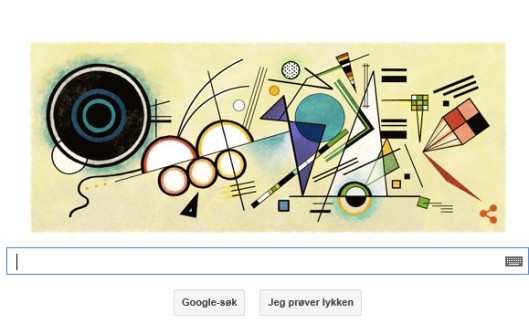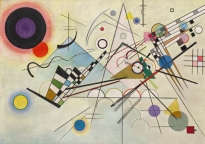Stikkord
Abstract forms, Abstract Paintings, Bauhaus, Wassily Kandinsky
Still having my eyes open for ABSTRACT DESIGN used in graphic art, I just discovered something interesting on Google this morning. To feature their opening page Google, had nicely rearranged «Composition 8» (see fig 2) an abstract painting by Wassily Kandinsky (1866-1944) to replace their logo (see fig 1). All this to celebrate Kandinsky’s (1866-1944) 148th birthday.
According to Artnson (2012), Kandinsky was one of the pioneers in terms of creating abstract art. He even claims himself as the first abstract painter in the world using colours, figures and geometrical shapes – organised with the only help of a spiritual mind. More recent research, however, shows that it was one artist that had created abstract spiritual paintings before him. Her name was Hilma af Klint (1862-1844), a Swedish painter who graduated from the Royal Swedish Academy of Fine arts in 1887 (Rachlin, 2013). Nevertheless, Kandinsky did a great job in terms of getting his abstract art work known to the world. In the early 20s he was one of the most established abstract artists. One can read about him in an issue of the American Art News from 1922 that he became a popular teacher among young Russian art students. The American Art News further writes:
Kandinsky himself, though representative of the extremists, is well aware of the necessity of mastering before everything the naturalistic forms before one is able to form abstract ideas. (American Art News, June 2014).
During his life as an artist Kandinsky’s did a great job to legitimate abstract art as an own discipline. Together with another artist, Paul Klee, he also taught and developed courses in colour theory and forms at the Bauhaus (Bretschneider, 2012). I think he definitely deserves to be celebrated. Happy Birthday to Kandinsky!
References:
American Art News, (1922). RUSSIA FAVORS NEW, BUT GUARDS OLD ART.
Arntson, A. (2012). Graphic design basics. 6th ed. Boston: Carl Baxter.
Bretschneider, M. (2012). The Bauhaus: Understanding its History and Relevance to Art Education Today.. East Tennessee State University.
Online sources:
Rachlin, N. (April 29, 2013) New York Times [Online newspaper article] At: http://www.nytimes.com/2013/04/30/arts/artsspecial/Giving-a-Swedish-Pioneer-of-Abstract-Art-Her-Due.html?_r=0&adxnnl=1&pagewanted=all&adxnnlx=1418740222-D9Xk/J/DIOdqM/uuZNVsxw (Accessed on 16.12.2014).
Image sources:
Figure 1: Google opening page (December 16, 2014) [Print screen]
Figure 2: Kandinsky, W. (1923) Composition 8 [Oil on canvas] At: http://www.guggenheim.org/new-york/education/school-educator-programs/teacher-resources/arts-curriculum-online?view=item&catid=716&id=150 (Accessed on 16.12.2014)


